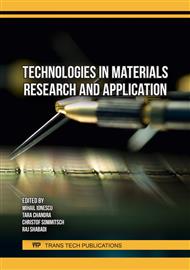[1]
Natural Environment research Council, "The greenhouse effect", British Geological Survey, 2023. https://www.bgs.ac.uk/discovering-geology/climate-change/how-does-the-greenhouse-effect-work/. (accessed May 5th, 2023).
Google Scholar
[2]
F. Betti and E. Boer, "Global Lighthouse Network: Unlocking Sustainability through Fourth Industrial Revolution Technologies,"World Economic Forum, 2021. https://www3.weforum.org/docs/WEF_Global_Lighthouse_Network_Unlocking_Sustainability_Through_4IR.pdf (accessed May 4th, 2023).
Google Scholar
[3]
H. Leurent, O. Abbosh, "Shaping the Sustainability of Production Systems: Fourth Industrial Revolution technologies for competitiveness and sustainable growth", World Economic Forum, 2019.https://www3.weforum.org/docs/WEF_Shaping_the_Sustainability_Production_Systems.pdf. (accessed April 25th, 2023).
Google Scholar
[4]
S. Schaltegger and M. Csutora, "Carbon accounting for sustainability and management. Status quo and challenges," Journal of Cleaner Production, vol. 36, p.1–16, 2012.
DOI: 10.1016/j.jclepro.2012.06.024
Google Scholar
[5]
A. Delubac, "5 Best Carbon Footprint Calculators", greenly, 2023. https://greenly.earth/en-gb/blog/company-guide/5-best-carbon-footprint-calculators. (accessed March 20th, 2023).
Google Scholar
[6]
"CARBON CALCULATOR: Carbon Footprint Calculator For Individuals And Households", carbon footprint, https://www.carbonfootprint.com/calculator.aspx (accessed March 28th, 2023).
DOI: 10.4135/9781412975704.n23
Google Scholar
[7]
L. Hillege "Life Cycle Assessment Software Tools – Overview" Ecochain, 2023. https://ecochain.com/knowledge/life-cycle-assessment-software-overview-comparison/ (accessed May 8th, 2023).
Google Scholar
[8]
L. Zhao-hui, Z. Wei-min, X. Zhong-yue, S. Jia-bin, and L. Dongdong, "Research on Extended Carbon Emissions Accounting Method and Its Application in Sustainable Manufacturing," Procedia Manufacturing, 43(2020) 175–182, 2020.
DOI: 10.1016/j.promfg.2020.02.132
Google Scholar
[9]
M. R. M. Saade, A. Yahia, and B. Amor, "How has LCA been applied to 3D printing? A systematic literature review and recommendations for future studies," Journal of Cleaner Production, 244 (2020) 118803.
DOI: 10.1016/j.jclepro.2019.118803
Google Scholar
[10]
F. Cerdas, M. Juraschek, S. Thiede, and C. Herrmann, "Life Cycle Assessment of 3D Printed Products in a Distributed Manufacturing System," Journal of Industrial Ecology, 21, (S1), (2017) S80–S93.
DOI: 10.1111/jiec.12618
Google Scholar
[11]
E. Rauch, P. Dallasega, and D. T. Matt, "Sustainable production in emerging markets through Distributed Manufacturing Systems (DMS)," Journal of Cleaner Production, 135, (2016)127–138.
DOI: 10.1016/j.jclepro.2016.06.106
Google Scholar
[12]
M. McFall-Johnsen, "The fashion industry emits more carbon than international flights and maritime shipping combined. Here are the biggest ways it impacts the planet.," Insider, 2019. https://www.businessinsider.com/fast-fashion-environmental-impact-pollution-emissions-waste-water-2019-10 (accessed May 02nd, 2023).
Google Scholar
[13]
M. Santamouris and K. Vasilakopoulou, "Present and future energy consumption of buildings: Challenges and opportunities towards decarbonisation," e-Prime - Advances in Electrical Engineering, Electronics and Energy, vol. 1,(2021) 100002.
DOI: 10.1016/j.prime.2021.100002
Google Scholar
[14]
C. Delmastro, "Buildings," iea, 2022. https://www.iea.org/reports/buildings (accessed May 02nd, 2023).
Google Scholar
[15]
Y Weng, M Li, S Ruan, TN Wong, MJ Tan, K Yeong, S Qian, "Compare economical, environmental and productivity assessment of a concrete bathroom fabricated through 3D printing and a precast approach", Journal of Cleaner Production 262 (2020) 121345.
DOI: 10.1016/j.jclepro.2020.121245
Google Scholar
[16]
A. Heath, K. Paine, and M. McManus, "Minimising the global warming potential of clay based geopolymers," Journal of Cleaner Production, 78 (2014) 75–83.
DOI: 10.1016/j.jclepro.2014.04.046
Google Scholar
[17]
B. Panda, S. C. Paul, L. J. Hui, Y. W. D. Tay, and M. J. Tan, "Additive manufacturing of geopolymer for sustainable built environment," Journal of Cleaner Production, 167 (2017) 281–288.
DOI: 10.1016/j.jclepro.2017.08.165
Google Scholar
[18]
G. H. Andrew Ting, T. K. Noel Quah, J. H. Lim, Y. W. Daniel Tay, and M. J. Tan, "Extrudable region parametrical study of 3D printable concrete using recycled glass concrete," Journal of Building Engineering, 50, (2022) 104091
DOI: 10.1016/j.jobe.2022.104091
Google Scholar
[19]
G. H. A. Ting, Y. W. D. Tay, Y. Qian, and M. J. Tan, "Utilization of recycled glass for 3D concrete printing: rheological and mechanical properties," Journal of Material Cycles and Waste Management, p.21 (2019) 994-1003
DOI: 10.1007/s10163-019-00857-x
Google Scholar
[20]
D. Wang, T. Zhang, X. Guo, D. Ling, L. Hu, and G. Jiang, "The potential of 3D printing in facilitating carbon neutrality," Journal of Environmental Sciences, 130 (2023) 85–91.
DOI: 10.1016/j.jes.2022.10.024
Google Scholar



